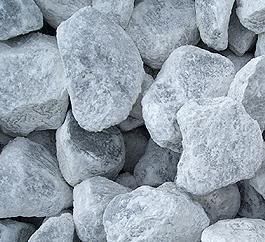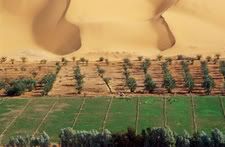Greening the desert by squeezing water out of gypsum
 A group of European scientists has come up with a suggestion on how to green deserts. Gypsum, a rocky mineral abundant in desert regions where fresh water is usually in very short supply, could become a new resource out of which trillions of liters of clean drinking water can be squeezed. The engineers of the 'Holland Innovation Team' describe their proposal in a special issue on 'Macro-Engineering', published in the International Journal of Global Environmental Issues.
A group of European scientists has come up with a suggestion on how to green deserts. Gypsum, a rocky mineral abundant in desert regions where fresh water is usually in very short supply, could become a new resource out of which trillions of liters of clean drinking water can be squeezed. The engineers of the 'Holland Innovation Team' describe their proposal in a special issue on 'Macro-Engineering', published in the International Journal of Global Environmental Issues.Water resources in the world are scarce and unevenly distributed. In deserts, the only source of water is groundwater, often saline and of poor quality. This limits agricultural activities. In those places where farming does occur, groundwater levels have dropped dangerously due to overexploitation.
However, deserts contain several resources which could be combined to help solve this problem in a relatively simple way: ample solar and fossil energy, and the magical ingredient, gypsum. Peter van der Gaag and colleagues have hit the idea of utilizing the untapped energy from oil and gas flare-off, or solar power, to release the water locked in the abundant rocks.
 Van der Gaag has already discussed the technology with people in the Sahara who agree that the idea could help combat water shortages, improve irrigation, and even make deserts fertile. As it happens, gypsum is also a very useful agromineral.
Van der Gaag has already discussed the technology with people in the Sahara who agree that the idea could help combat water shortages, improve irrigation, and even make deserts fertile. As it happens, gypsum is also a very useful agromineral.So how does the technique to squeeze water out of rocks work? Chemically speaking, gypsum is calcium sulfate dihydrate, with the formula CaSO4.2H2O. In other words, for every unit of calcium sulfate in the mineral there are two water molecules, which means gypsum is 20% water by weight.
The scientists describe both large-scale engineering and micro-scale projects to tap the resource. The process would require energy, but this could be supplied using the energy from oil and gas fields that is usually wasted through flaring. Alternatively, small scale solar thermal systems could provide the necessary heat.
Van der Gaag explains that it takes only moderate heating, compared with many chemical reactions, to temperatures of around 100° Celsius to liberate water from gypsum and turn the mineral residue into bassanite, the anhydrous form.
Dehydration under certain circumstances starts at 60 Celsius, goes faster at 85 Celsius, and faster still at 100 degrees. So in deserts - where there is abundant sunlight - it is very easy to do. - Peter van der GaagVan der Gaag points out that the dehydration of gypsum results in a material of much lower volume than the original mineral, so the very process of releasing water from the rock will cause local subsidence, which will then create a readymade reservoir for the water. Tests of the process itself have proved successful and the Holland Innovation Team is planning a pilot study in a desert location:
 energy :: sustainability :: biomass :: bioenergy :: agriculture :: land :: water :: gypsum :: Sahel :: Sahara ::
energy :: sustainability :: biomass :: bioenergy :: agriculture :: land :: water :: gypsum :: Sahel :: Sahara :: So how large are the 'reserves' of this 'stored' water resource? Van der Gaag speaks in terms of billions of tonnes of recoverable gypsum, amounting to a potential to tap off trillions of liters of clean water.
The macro-engineering concept of dewatering gypsum deposits could solve the water shortage problem in many dry areas in the future, for drinking purposes as well as for drip irrigation, he concludes. On a micro-scale, solar thermal technologies could serve small communities with access to deposits of this mineral.
The team collaborated with a state-run mining company in Mauritania and one in France, to test the technique on different types of gypsum. The Sebkha N’Drahamcha mine in Mauritania alone contains 140 million tonnes of recoverable, nearly pure gypsum of which only a few thousand tonnes are mined each year.
References:
Van der Gaag, Peter. "Mining water from gypsum", International Journal of Global Environmental Issues, Special Issue on Macro-Engineering: How to Deal with Global Problems?, 2008 - Vol. 8, No.3 pp. 274 - 281.
 --------------
--------------
 Mongabay, a leading resource for news and perspectives on environmental and conservation issues related to the tropics, has launched Tropical Conservation Science - a new, open access academic e-journal. It will cover a wide variety of scientific and social studies on tropical ecosystems, their biodiversity and the threats posed to them.
Mongabay, a leading resource for news and perspectives on environmental and conservation issues related to the tropics, has launched Tropical Conservation Science - a new, open access academic e-journal. It will cover a wide variety of scientific and social studies on tropical ecosystems, their biodiversity and the threats posed to them.









2 Comments:
Very interesting.
If the economics don't work, sustainable efforts won't either.
Check Http://LivePaths.com, a blog about innovative entrepreneurs that make money selling recycled items, provide green services or help us reduce our dependency on non renewable resources. These include some very cool Green online ventures, great new technologies, startups and investments opportunities.
What an amazing misuse of technology! It will waste enormous amounts of energy to get limited amounts of water -- something that could be done simply and cheaply by CAPTURING water.
Most rain and snow in deserts evaporates or runs off, rather than staying in soil to grow plants or recharging groundwater. To capture more water, simply change the soil surface conditions. See the short tutorial "Water Cycle Basics":
http://managingwholes.com/photos/index.htm
or this graphic demonstration on YouTube:
http://youtube.com/watch?v=og9cQKxlFnE
Capturing just 1 inch (25 mm) more rainfall per year means 27,225 U.S. gallons more water per acre (254,530 liters per hectare). Improving water capture on 3% of the desertified land in the western U.S. would capture 1 trillion liters (264,172,050,000 U.S. gallons) of water PER YEAR, forever.
Increasing water capture is low-tech, environmentally beneficial, inexpensive, and pulls carbon out of the air to build topsoil. And it's sustainable forever. It uses existing technology, and could be implemented TODAY.
Want to help it happen? Donate to soilcarboncoalition.org or ecoresults.org.
Post a Comment
Links to this post:
Create a Link
<< Home